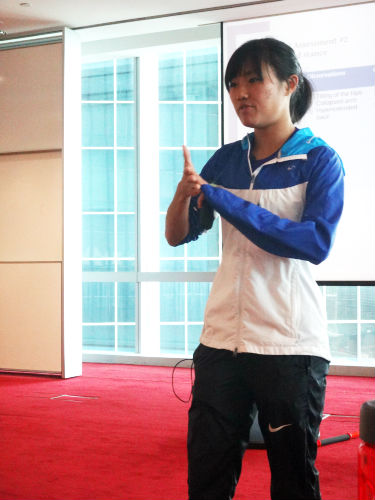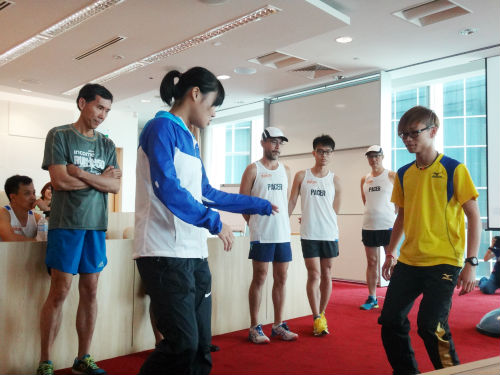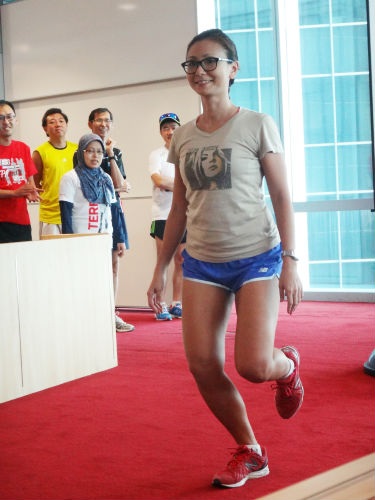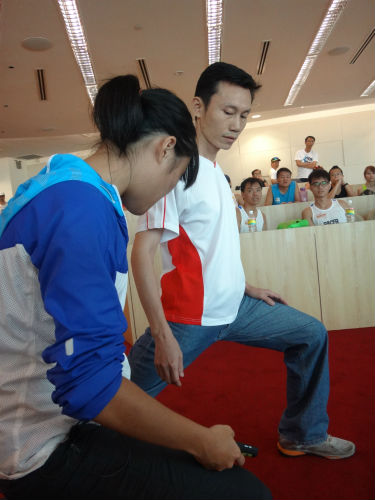She is an accomplished athlete and distance runner, with a number of accolades to her name. These include a second-placed finish in the Standard Chartered Marathon Singapore (42km, December 2013) and winning the Race Against Cancer three times, between 2010 to 2013.
As part of the pre-race preparations for the NTUC Income Run 350 on 27 April, Mok Ying Rong – the younger sister of 2013 SEA Games marathon gold medallist Mok Ying Ren – gave a talk on running injury-free.
Ying Rong shared her thoughts on warm-up exercises and tests to gauge likely injuries. At the talk, Ying Rong also gave lively demonstrations and shared video excerpts of the exercises.
Warm-Up Exercises
For short distances of up to 10km, doing some form of warm-up drills is very important before a run, according to Ying Rong. This is because if you skip the warm up, you may get premature muscle cramps and fatigue. Therefore, you won’t be able to complete the race to the best of your abilities.
For longer runs though, such as the half and full marathons, such warm-up exercises may not be so important and you can even shorten the warm-up exercises.
There are four different drills that should be done as a form of warm-up, before embarking on a run. These are as follows.
Skipping
This drill should be done with high arm swings and good arm/leg coordination. And if you feel stiff doing it, this may indicate that your body is not generating enough momentum to drive you forward – and may affect your running.
High Knee Lifts
For this exercise, you should try and raise your knees as high as possible – to improve your running stride.
Butt Kicks
This drill can be either a dynamic or static warm-up. The dynamic version is where you move while kicking your butt. For the static version, you stay in one position as you kick. Butt kicks improves your glutes and hamstrings.
Backwards Running
Instead of running forwards, you run backwards. Doing this warm-up drill allows your hamstring muscles to contract – thus helping to prevent hamstring strains during running.
Start your run at an easy pace – for long runs
After an optional warm-up, for long runs such as half and full marathons, start your run at a very slow and easy pace. For the first three to five kilometres, run at a pace that is about 30 to 50 per cent slower than your race pace. Then you slowly move into your intended race pace for the rest of your run.
Functional Assessment to Gauge Likely Injuries
Tests or functional assessment exercises were also recommended, to assess where your weaknesses are, in terms of getting running injuries. This is a quick way to discover any biomechanical imbalances in runners.
However, it was pointed out that only a trained observer is able to do these assessments and teach you how to prevent injuries – to become a stronger runner.
So see a sports physiotherapist for these assessment exercises.
The four functional assessment tests are:
Test 1: Double Legged Squat
This is a test that you do when squatting down with both legs. It can indicate whether you have small running strides, reduced running efficiency and/or strained calf muscles.
The trained observer would look out for signs such as one knee being higher than the other, feet pointing outwards and/or leaning backwards – while squatting.
Test 2: Single Legged Stance
While you are standing on one leg and maintaining your balance, the observer will be able to see whether your hips are tilted or whether the arch in your foot is collapsed.
If you don’t pass this test, it could mean that you have muscular imbalance. This puts you at a high risk of having ankle sprains.
Test 3: Single legged squats
For this test, you would stand on one leg and then squat.
While you are doing this, you would then be able to see whether you have a pelvic tilt and/or loss of balance.
For runners who fail this functional assessment, they would have a higher risk of sustaining ITB band syndrome and runners’ knee injuries.
Test 4: Dynamic lunge
This assessment requires you to do lunges in motion – in a controlled manner. And because false readings arise if you do the lunges too quickly, you must be careful not to rush through this test.
If you find that you are frequently losing your balance and that your ankles are constantly swaying whilst doing the lunges – you may be at a higher risk of shin splints.
So for running injury-free – do your warm-ups and have a functional assessment done, to gauge likely injuries.





Hello, Mok. Thank you for sharing your knowledge about running. I try to become a professional runner, too; however, I am afraid that I won’t be able to run for long distances. The thing is that I have a runner’s knee. Actually, I’ve been running for years, so the condition popped up… My point is, have you ever heard about dynamic neuromuscular stabilization? I want to try it at NYDNRehab clinic. What do you think about it? I mean, a friend of mine went to this clinic and they did wonderfult things with him. He runs as a wild cat now. He forgot about injuries and stuff. So, what do you think?
Please check my reply via email.